The 12 birds of Christmas
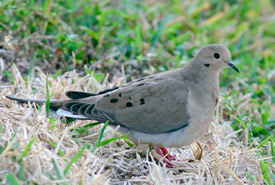
Mourning dove (Photo by Ken Schneider)
On the 12th day of Christmas, my true love gave to me…fun bird facts! To celebrate the holidays this year, here are some interesting tidbits about 12 different birds found in Canada, some of which are featured in the 12 Days of Christmas song:
A grey partridge in a pear tree
The grey partridge is native to Eurasia, but was introduced to North America in the 1790s. Don't let the song fool you: grey partridges don't actually perch on pear trees — or any trees for that matter. Instead, they prefer to stay on the ground.
Two mourning doves
Mourning doves are one of North America’s most abundant bird species, with an estimated population of six million in Canada. In winter, they often visit bird feeders, which in turn can attract Cooper’s hawks and other birds of prey that feed on them.
Three greater prairie chickens
Male greater prairie chickens are known for their elaborate — and unusual — mating dances. After gathering at communal courtship display areas, called leks, males have group “dance-offs” to attract females. Their dances consist of raising their feathers above their heads, inflating their orange throat sacs and moaning deeply.
Four red-winged blackbirds
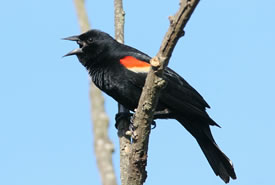
Red-winged blackbird (Photo by Bill Hubick)
The original 12 Days of Christmas song mentions “colly birds,” an Old English term for “blackbirds.” During the breeding season, male red-winged blackbirds, one of the most common North American blackbird species, are highly territorial, chasing away other males and attacking intruders.
Five golden-winged warblers
The golden-winged warbler has experienced one of the largest population declines of any songbird species — around 68 per cent between 1966 and 2014. A major cause of this has been increased mating between golden- and blue-winged warblers, resulting in hybrid offspring that are sometimes called Brewster’s and Lawrence’s warblers.
Six Canada geese a laying
Canada geese are known for their distinct V-shaped flying formations. This pattern helps them to better coordinate their movements, such as when changing direction or speed.
Seven trumpeter swans a swimming
The trumpeter swan got its name from its low-pitched, trumpet-like call. Weighing between 7.7 kilograms and 12.7 kilograms, it is North America’s heaviest bird species.
Eight brown-headed cowbirds a milking
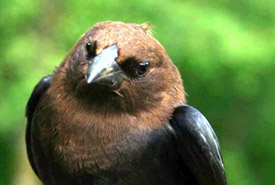
Brown-headed cowbird (Photo by Stephen Davis)
The brown-headed cowbird is North America’s most common brood parasite: females lay eggs in other birds’ nests instead of constructing their own. When the cowbird chicks hatch, the “foster” parents feed them at their own offspring’s expense.
Nine greater sage-grouses dancing
Like male greater prairie chickens, male greater sage-grouses have intricate mating dances. They inflate and deflate their throat sacs to make popping noises, throw their heads back, spread their wings and fan their tails.
Ten American woodcocks a leaping
On spring nights, male American woodcocks repeatedly make buzzy “peent” calls and then fly in upward spirals to attract females. They then zigzag downward while chirping and land right near a female, if one is present.
Eleven plovers piping
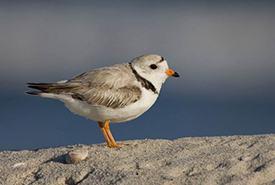
Piping plover (Photo by Natural Resources Canada)
Male piping plovers with shared territory boundaries do parallel-run displays, where one bird runs a short distance and stops, then the other runs past the first and stops. They keep doing this until they’ve run out of space, then they chase one another back to the starting point.
Twelve ruffed grouses drumming
To attract mates and defend their territories, male ruffed grouses “drum” the air by quickly flapping their wings in front of their bodies while standing on logs.
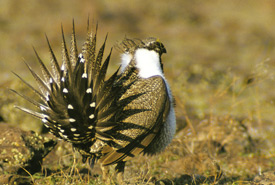
Greater sage-grouse (Photo by Gordon Sherman © Audubon Canyon Ranch)
Sadly, some of these birds are at-risk species — namely the greater prairie chicken, golden-winged warbler, greater sage-grouse and piping plover. You can help these species by supporting the Nature Conservancy of Canada (NCC) in protecting their habitat and by participating in bird counts that provide valuable data to inform conservation work. Earlier this month, the Nature Conservancy of Canada (NCC) hosted Christmas bird count events. If you missed these events, it’s not too late: Bird Studies Canada has Christmas bird counts planned across Canada up until Friday, January 5, 2018.


